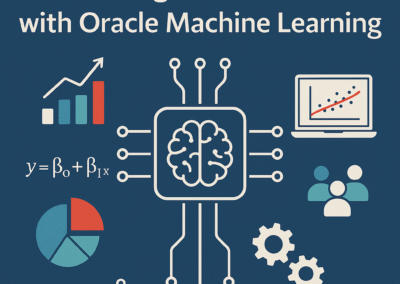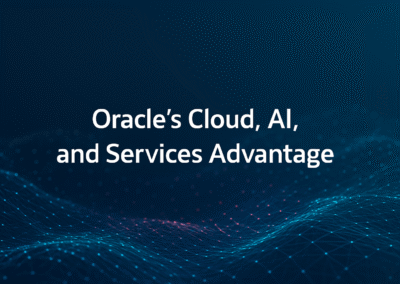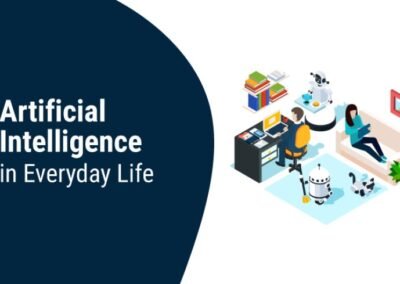Executive Summary:
In a rapidly evolving digital economy, the ability to learn from data at scale is a critical differentiator. Oracle Machine Learning (OML) delivers a unique and integrated platform to embed machine learning into databases, applications, and business workflows. Unlike fragmented AI toolkits that operate outside core systems, OML allows organizations to operationalize predictive analytics directly within Oracle Database and Oracle Cloud Infrastructure (OCI), reducing data movement, latency, and complexity.
This white paper explores the fundamentals of machine learning, how Oracle implements these capabilities, the mathematical models underpinning predictive intelligence, and real-world use cases across industries. Businesses that leverage OML gain faster insights, better decisions, and greater ROI from their data investments.
Introduction: Why Machine Learning Matters Now
Machine learning (ML) enables systems to recognize patterns and make data-driven predictions without explicit programming. In today’s data-rich landscape, enterprises need more than just reports — they need models that learn from history and predict outcomes to proactively steer operations.
Oracle Machine Learning is embedded into Oracle’s cloud and database offerings, giving customers an edge by integrating AI into their existing data estate with minimal disruption.
Oracle Machine Learning: Core Components
Oracle Machine Learning supports development and deployment of ML models using popular languages — SQL, Python, R, and AutoML — directly in the database. Key components include:
- OML4SQL – Enables in-database ML with simple SQL commands.
- OML Notebooks – Web-based environment for collaborative development using SQL, Python, and R.
- OML AutoML – Automates algorithm selection, feature engineering, and model tuning.
- OML Services on OCI – Managed ML services for model training, deployment, and scoring at scale.
- OML for Python (OML4Py) – Python interface for in-database execution of ML workloads.
The Mathematical Models Behind Oracle Machine Learning
OML supports a variety of supervised and unsupervised learning algorithms based on well-established mathematical foundations:
1. Linear and Logistic Regression
- Use: Predicting numeric values or binary outcomes (e.g., churn likelihood).
- Math Basis: Solves for coefficients in
using least squares or maximum likelihood estimation.
2. Decision Trees & Random Forests
- Use: Classification, fraud detection, customer segmentation.
- Math Basis: Recursive binary splits that minimize Gini impurity or entropy.
3. Support Vector Machines (SVM)
- Use: Text classification, pattern recognition.
- Math Basis: Finds the hyperplane that best separates classes in high-dimensional space.
4. K-Means Clustering
- Use: Market segmentation, anomaly detection.
- Math Basis: Minimizes intra-cluster variance (Euclidean distance) to group similar data.
5. Neural Networks
- Use: Forecasting, image or voice recognition.
- Math Basis: Layers of weighted sums and activation functions like sigmoid, ReLU.
6. Naïve Bayes
- Use: Spam filtering, recommendation systems.
- Math Basis: Probabilistic inference using Bayes’ Theorem with independence assumptions.
Business Benefits of Oracle Machine Learning
In-Database Processing
No need to move data to external tools — OML executes algorithms where the data resides. This boosts security, reduces latency, and improves performance.
Scalability
OML handles billions of rows natively in Oracle Autonomous Database and Exadata, suitable for large enterprises and mission-critical workloads.
Security and Governance
Built-in role-based access, audit controls, and data masking protect sensitive data, especially vital for finance, healthcare, and government sectors.
Ease of Use with AutoML
Even non-experts can produce accurate models using Oracle AutoML UI, which automates algorithm selection, training, and evaluation.
Operational Integration
Embed models directly into applications (e.g., Oracle Fusion, NetSuite) or REST APIs for real-time scoring.
Real-World Use Cases Across Industries
Finance: Credit Risk and Fraud Detection
- Train models to detect anomalies in transaction patterns.
- Score customers in real-time for creditworthiness using in-database logistic regression or SVM.
Retail: Personalized Recommendations
- Use clustering to segment customers.
- Leverage association rules to generate dynamic product suggestions.
Manufacturing: Predictive Maintenance
- Analyze sensor and IoT data to forecast equipment failure.
- Use time-series and regression models for proactive service planning.
Healthcare: Patient Outcome Prediction
- Classify patients by readmission risk.
- Optimize treatment paths using decision trees and random forests.
Public Sector: Tax Compliance and Citizen Services
- Identify patterns of tax evasion or fraud.
- Forecast demand for public services and optimize resource allocation.
Example Scenario: Predicting Churn in a Subscription Business
A media company using Oracle Autonomous Database wants to reduce churn. Using OML4SQL:
- Data engineers prepare data via SQL queries (e.g., demographics, usage history).
- AutoML evaluates multiple models — logistic regression, decision trees, SVM.
- The best model is selected based on AUC (Area Under the Curve) for evaluating classification models and deployed as a REST API.
- Marketing teams receive weekly predictions on high-risk customers and trigger retention campaigns.
Outcome: Churn reduced by 15% over three months; campaign ROI improved 3x.
Oracle’s Differentiators in the AI/ML Space
| Capability | Oracle OML | Other ML Platforms |
|---|---|---|
| Data Movement | None (in-database) | High (requires ETL: Extract → Load → Transform) |
| Security | Database-native | Often separate layer |
| Scalability | Exadata / Autonomous DB | Dependent on external infra |
| Governance | Built-in auditing & access control | Often bolt-on |
| Integration | Embedded in apps (Fusion, NetSuite) | Limited integration |
Getting Started with Oracle Machine Learning
- Adopt Autonomous Database on OCI – Enables AutoML and notebooks out of the box.
- Train Teams on OML Notebooks – Upskill analysts to build models using SQL and Python.
- Start with a Pilot Project – Choose a use case with measurable ROI: e.g., churn, fraud, or demand forecasting.
- Operationalize Quickly – Embed ML scoring into daily workflows via REST APIs or SQL pipelines.
Conclusion
Oracle Machine Learning represents a paradigm shift: no more silos, no more duplicating infrastructure for analytics, and no more delays in getting from data to decision. With OML, machine learning becomes a seamless part of business operations — delivering trusted, timely, and transformative insights.
Organizations ready to lead in the AI era should look to Oracle’s tightly integrated, scalable, and secure ML platform as the foundation for intelligent enterprise growth.









